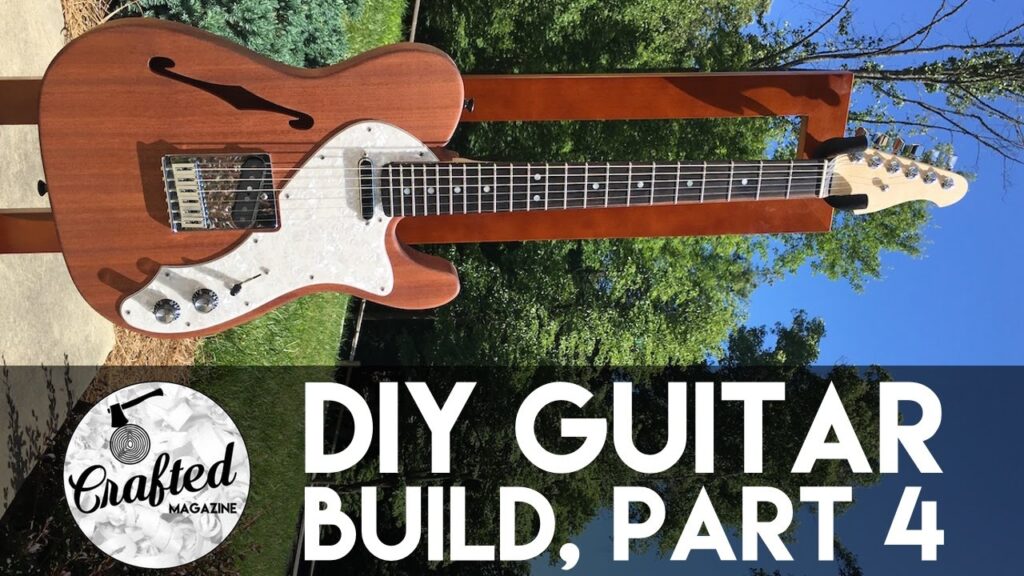Hey there! Welcome back to the fourth and final part of the DIY Guitar (Telecaster) Build Series brought to you by Crafted Workshop. In this last installment, we’re going to take you through the exciting process of the final assembly of the guitar. We’ll cover everything from drilling holes for the strings, rounding over the edges, sanding, applying the finish, and installing the tuners, pick guard, jack plate, and bridge. The end result is a stunning guitar with a beautiful finish and high-quality hardware that produces a wide range of tones. So sit back, relax, and let’s dive into the final steps of this incredible DIY build!
Alright, guys, the moment we’ve all been waiting for has finally arrived – the guitar is complete! In the last part of the video, we finished assembling all the parts onto the body, stringing it up, and adding the final touches. Let me tell you, this guitar turned out absolutely beautiful. The Sapele body and Birdseye Maple neck make for a visually striking combination, and the Danish Oil finish really brings out the natural grain of the wood. Plus, the Lawler Vintage T pickups and the GoTable bridge deliver outstanding sound quality. I couldn’t be happier with the results, and I’m excited to show you a quick tone demo in this video, so stick around until the end. And remember, if you enjoyed this build, don’t forget to subscribe to our YouTube channel and consider supporting us on Patreon. Happy playing and happy building!
DIY Guitar (Telecaster) Build Series, Part 4 | Crafted Workshop
Drilling Holes and Rounding Over Edges
In this final part of the DIY Guitar (Telecaster) Build Series, we will focus on the finishing touches of the guitar. First, we need to drill holes for the strings to go through the body and the holes for the string ferrules. Using a drill press for this task ensures that the holes are straight and precise.
Next, we need to round over the edges of the guitar to give it a smooth and polished look. Using a compact router and an eighth inch radius Whiteside Roundover bit, we can easily achieve this. It is important to round over both the front and back edges of the guitar. Although footage of this process may have been lost, it is a simple and straightforward step.
Sanding and Applying Finish
After rounding over the edges, it is time to sand the guitar to remove any tool marks and prepare it for the finish. Starting with 120 grit sandpaper, sanding the edges is the first step. Then, using the same 120 grit paper, sand with the grain on the front and back sides of the guitar. Sanding with the grain is recommended for this circumstance.
After removing the tool marks, it is necessary to move up to 220 grit sandpaper for a finer finish. If you only have sanding disks in 220 grit, wrapping them around a dowel can help maintain even pressure while sanding. Finally, using a random orbital sander with 320 grit sandpaper, give the guitar a final sanding finish.
To achieve a beautiful finish, Danish Oil is the chosen product. Apply the oil generously and let the wood soak it up. This process may need to be repeated several times until the wood stops absorbing the oil. After 24 hours, lightly sand the surface with 320 grit paper and remove any dust. Repeat the flooding process with the Danish Oil, wiping off the excess.
Alternatively, you can let the finish cure for about 72 hours after two coats of Danish Oil. Sanding the surface with 320 grit paper and applying a third coat is also an option. Ultimately, the choice depends on personal preference and the desired level of finish.

This image is property of i.ytimg.com.
Installing Hardware
Once the finish has cured, it is time to install the hardware and assemble the guitar. Start by installing the tuners on the neck. Eyeballing the alignment should suffice, ensuring that the tuners are straight and even.
Next, check if any adjustments are necessary for the pick guard. If the pick guard you have does not follow Fender’s specs for hole spacing, you may need to add additional holes. This step is important before installing the control cavity.
Drill a hole for the jack plate and input jack using a Forstner bit. This hole should provide easy access to the input jack with the jack plate installed securely with four screws.
To allow the pickup wires to connect with the controls, drill quarter-inch holes from the pickup cavities into the control cavity. This step ensures that the wiring can be easily managed and concealed within the guitar.
After completing these steps, it is time to install the bridge. While a traditional Telecaster bridge is not used in this build, the go table bridge offers adjustability for intonation. Loosen the saddles, turn them on their sides, and access the holes for the bridge screws. Additionally, install string ferrules on the back of the guitar.
Position the pick guard where desired, drill holes for screws, and attach the pick guard securely. Lastly, install the strap buttons to complete the guitar assembly.
The Final Product
The guitar is now complete and ready to play. The overall outcome of this DIY Guitar (Telecaster) Build Series is a beautiful guitar with high-quality hardware. The Sapele body, Birdseye Maple neck, and Ebony fretboard create an aesthetically pleasing and sonically rich instrument.
The guitar’s specifications include a 25-1/2″ scale, a Standard Thin neck profile, and a 10″-16″ compound radius. With 22 frets and SS6105 Stainless fret size, the guitar offers a comfortable and versatile playing experience. The GraphTech White TUSQ XL string nut and Clear Satin Nitro finish contribute to the guitar’s quality and durability.
In terms of tone, the guitar produces a wide range of sounds thanks to the Lawler Vintage tea set pickups. The wiring system, which includes the solder-free Electrics wiring kit, offers various tonal options for customization, making this guitar versatile and suitable for different playing styles and genres.

This image is property of pixabay.com.
Conclusion and Future Builds
Congratulations on completing the DIY Guitar (Telecaster) Build Series! The Crafted Workshop team hopes that this series has been helpful and enjoyable for you. If you have not already, consider subscribing to our YouTube channel for more woodworking and metalworking content. We have a lot more in store, and we would love to have you join our community.
Building a guitar from scratch is not a simple task, and it requires time, patience, and dedication. We appreciate your support and feedback throughout this series. If you would like to support future builds like this, please consider becoming a patron on our Patreon page. Your contribution helps us continue creating content and bringing new projects to life.
Thank you for following along with the DIY Guitar (Telecaster) Build Series, and we hope that you have gained valuable knowledge and inspiration from this experience. Happy playing and happy building!









